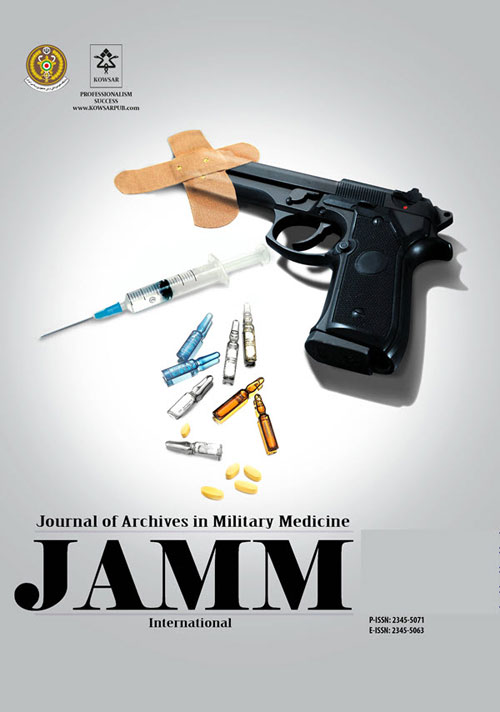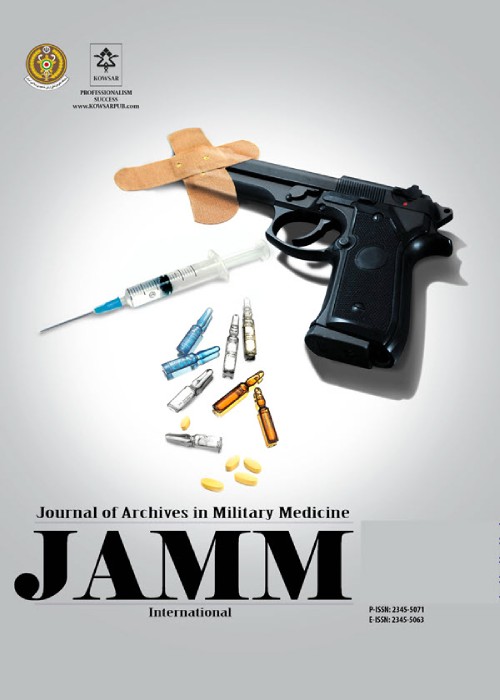فهرست مطالب

Journal of Archives in Military Medicine
Volume:7 Issue: 4, Dec 2019
- تاریخ انتشار: 1399/07/05
- تعداد عناوین: 6
-
-
Page 1
The new coronavirus disease 2019 (COVID-19) has recently emerged as an acute respiratory syndrome. The virus has spread throughout the world since the primary outbreak of the disease reported in Wuhan, China. The pandemic has led to increased mortality as the most important threat of the disease in specific populations across the world. Furthermore, COVID-19 has caused significant economic problems in several countries. The early diagnosis of COVID-19 is currently an important concern for physicians and communities. The present study aimed to review the published articles regarding the diagnosis of COVID-19 until the end of February 2020. According to the results, deep learning and machine learning algorithms could effectively contribute to the diagnosis of the disease.
Keywords: COVID-19, Coronavirus Disease, Deep Learning, Machine Learning, Diagnosis -
Page 2Background
Toxoplasmosis is a tropical disease that is opportunistic in immunocompromised patients.
ObjectivesIn this research, our goal was to assess the anti-parasitic effect of silver nanoparticles (Ag-NPs) based on ginger extract on T. gondii tachyzoites.
MethodsThis study was conducted to assess the effects of various concentrations of nanoparticles on the parasite using light microscopy. The MTT assay was also conducted to evaluate the toxic effects of silver nanoparticles based on ginger extract on macrophage cells. In addition, the potential apoptosis of T. gondii by silver NPs was assessed using the flow cytometry technique.
ResultsBased on the tachyzoite assay using microscopic examination, it was observed that the higher the NPs concentration and the longer the parasite’s exposure to NPs, the greater the lethal effect of NPs on tachyzoites. The IC50 (inhibitory concentration) for NPs against T. gondii tachyzoites was 2 ppm. Also, according to the MTT assay, the 40 ppm concentration of nanoparticles had the most toxic impact on macrophages. Moreover, silver NPs led to apoptosis in approximately 55.22% of tachyzoites based on the flow cytometry technique.
ConclusionsBased on the above results, it is concluded that silver nanoparticles based on ginger extract have a lethal effect on T. gondii and induce apoptosis in this parasite. This study encourages further studies in vivo.
Keywords: Toxoplasma gondii, Tachyzoite, Silver Nanoparticles, MTT, Flow Cytometry -
Page 3Background
It has been assumed that during and after BFR exercises, many blood factors are activated and angiogenesis response is stimulated in the arteries.
ObjectivesTherefore, the current study aimed to determine the effect of two eccentric resistance training methods with and without blood flow restriction on serum IL6 and MMP9 levels in active young men.
MethodsIn this quasi-experimental study, 16 healthy men with a mean age of 27.8 ± 2.85 (years), the weight of 79.4 ± 12.4 (kg), and a body mass index of 25.5 ± 3.7 (kg/m2 ) were randomly assigned to either low-intensity eccentric group with BFR or the highintensity eccentric without BFR. The high-intensity (70% - 80% maximum voluntary contraction MVC) eccentric exercise without BFR included 3 - 5 cycles of eccentric contraction of the quadriceps muscles, up to exhaustion, whereas low-intensity eccentric exercise executed similar exercise modality at intensity of 20% - 30% MVC with blood flow restriction up to exhaustion. Blood samples were taken from antecubital both before and after the exercise to measure serum IL6 and MMP9 values using the ELISA method. Data were analyzed using paired t-test and analysis of variance with repeated measure test in SPSS version 22. A P value of < 0.05 was defined as statistically significant.
ResultsHigh-intensity resistance per se and low-intensity resistance exercise with BFR similarly resulted in a non-significant reduction of IL-6 and elevated levels of MMP-9 serum levels in active young men.
ConclusionsOverall, the results indicated that a low-intensity resistance exercise session with restricted blood flow and a highintensity resistance exercise without blood flow restriction equally did not affect IL6 and MMP9 serum of active young men. Further studies are needed to clarify the exact exercise modality that sufficiently stimulates angiogenesis.
Keywords: Active Men, Eccentric Resistance Exercise, Blood Flow Restriction, IL6, MMP9 -
Page 4Background
The mortality rate of out-of-hospital cardiac arrest (OHCA) is high and it’s shown that bystander CPR increases the survival rate of these patients by two to three-folds. Several methods are introduced to improve the acquisition and retention of CPR-related knowledge learned in courses.
ObjectivesThe current study aimed to compare three different methods of teaching CPR in terms of primary acquisition and retention of such skills in soldiers.
MethodsThis study was performed from November 2019 to February 2020 on selected duty male soldiers doing their military service. Participants were randomized into 1 of the following 4 groups: (1) A lecture-based, 30-minute class session followed by a one-hour practice on a manikin; (2) a 20-minute instructional video followed by a one-hour practice on a manikin; (3) a 20-minute instructional video without practice on a manikin (video only); and (4) no intervention. The performance and retention of CPR skills were assessed using a checklist by two referees. The preparation score, ABC score, and total score were assessed using this checklist.
ResultsFifty male participants with a mean age of 22.44 ± 2.08 years were included. The median score of groups 1 - 3 increased significantly after the intervention compared to the pre-test results. Group 3 (video only) experienced the highest increment in the preparation score (2.30). Concerning the ABC and total scores, group 1 (class session) showed the highest increment of scores (22.70 and 24.82, respectively). Group 3 (video only) showed the most sustained results compared to groups 1 and 2 one month after the intervention.
ConclusionsAccording to the results, the classroom session teaching with a manikin practice accompanied better acquisition of CPR skills. However, the retention of CPR skills is better maintained with a simple video-only method.
Keywords: CPR Performance, Resuscitation, Cardiac Arrest, CPR Training, Retention, Soldiers -
Page 5Background
Surgical site infection (SSI) includes infections occurring after 48 hours of any surgery and accounts for most of the healthcare-associated infections (HAIs) in surgical centers. Surgical site infections can result in pain, discomfort, prolonged hospital stay, increased exposure to antimicrobials, and consequentially, increased healthcare costs.
ObjectivesThe study intended to characterize the incidence, etiology, and emerging resistance of SSI in a 1000-bed tertiary-care teaching hospital in New Delhi.
MethodsThe ambispective study was conducted in a 1000-bed tertiary-care teaching hospital in New Delhi. Clinical, laboratory, and environmental surveillance and screening of health care providers (HCPs) were conducted using the National Healthcare Safety Network (NHSN) definitions and methods given by the US Centers for Disease Control and Prevention (CDC).
ResultsWith 3,541 patients admitted to the Gynecology and Obstetrics Ward and General Surgical Ward of the hospital, the total episodes of SSI were 80 (2.26%). The mean rates of superficial, deep, and organ space SSI were 46.25%, 47.5%, and 6.25%, respectively. The most common organisms isolated were Acinetobacter baumannii (23.75%), Pseudomonas aeruginosa (17.5%), Escherichia coli (15%), and Staphylococcus aureus (12.5%).
ConclusionsThe rate of SSI in our study was comparable to the unadjusted rates in India, lower-middle, upper-middle, and highincome countries worldwide. Patients with pre-existing medical illness, prolonged operation time, and wound contamination are strongly predisposed to surgical site infection.
Keywords: Surgical Site Infection (SSI), Device-Associated Healthcare-Associated Infections (DA-HAI), US Centers for Disease Controland Prevention (CDC) -
Page 6Background
The beneficial effects of pre-cooling techniques on endurance training have been proved, although few studies are conducted on the effects of pre-cooling techniques on high-intensity exercises
ObjectivesThe current study aimed to determine the effects of 30-minute whole body pre-cooling on anaerobic performance indices in women futsal players.
MethodsTwelve female subjects (age 22.5 ± 2.24, hight159 ± 0.06, weight 55.22 ± 12.73) participated in this cross-design study and were tested randomly after either 30- minute of pre-cooling using ice jackets or under control conditions (no pre-cooling) in two separate sessions with three days interval between each session. This was immediately followed by the RAST anaerobic power test. Buerer FT-70digital thermometer, polar-FT60 heart rate monitoring, micro lifeblood pressure monitoring, hp-cosmos lactometer, and ELISA technique were used to measure core body temperature, heart rate, blood pressure, blood lactate, and Lactate dehydrogenase, respectively. T-independent and dependent tests were also applied to compare changes both between and within groups.
ResultsData on core temperature, heart rate, maximum power output, and fatigue index after pre-cooling were significantly higher in the pre-cooling group than the control group (P < 0.05), but no significant difference was observed between the groups concerning the blood lactate levels, mean and minimum power output, and blood pressure (P < 0.05).
ConclusionsIn conclusion, the results suggest that 30-minute of whole-body pre-cooling improves repeated bouts of intensive activity through the occlusion of skin vessels to stimulate the blood flow to the active muscles.
Keywords: Futsal, RAST Test, Whole-Body Pre-Cooling


